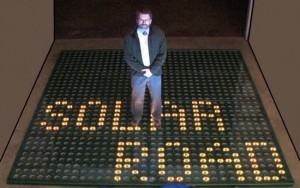Energy Efficiency
Paving the way to new energy with solar powered roads!
Imagine a world in which roads melt snow as it settles. Expensive and slow snow removal would be a thing of the past. Roads and vehicles would suffer less weather damage, and the nation would save the money lost to snow days and lost productivity.
If an electrical engineer from Idaho gets his way, the roads of the future will not only melt snow, they’ll also provide electric energy through a nationwide connection of solar-gathering roadways. Scott Brusaw isn’t some mad engineer howling in the wasteland, either; his plan has the attention of both the federal government and General Electric. And if his idea becomes reality, we’ll see a sharp increase in heavy equipment jobs for roadways.
 Brusaw’s ambitious plan would replace today’s asphalt and concrete roadways with a super-strong, heat-absorbing glass material. Trapped within the glass would be solar cells. The power generated from these cells would run embedded heating elements, which would keep the road surface at a constant temperature and melt ice and snow as it accumulates.
Brusaw’s ambitious plan would replace today’s asphalt and concrete roadways with a super-strong, heat-absorbing glass material. Trapped within the glass would be solar cells. The power generated from these cells would run embedded heating elements, which would keep the road surface at a constant temperature and melt ice and snow as it accumulates.
In addition, energy captured by solar cells could be used to support the local power grid, recharge electric cars, and power street and construction lights. A constant temperature would help prevent potholes and ruts caused by road materials contracting and expanding in different weather conditions.
The idea of driving on glass sounds unpleasantly like driving on ice, but Brusaw’s roads would offer the same traction as a traditional asphalt or concrete road. The solar cells would gather power even in gridlocked traffic, although only at 50 percent of their maximum potential.
Brusaw’s vision also solves one of the biggest obstacles to solar power: lack of space. Solar energy produces 20 to 60 megawatts for every 3,280 square feet of solar panels. A solar farm takes up room that could otherwise be used for cultivation or conservation. Replacing traditional road surfaces with Brusaw’s solar-gathering roads would provide the United States with a nationwide solar network on land that already has a purpose.
Before you start looking into solar equipment mechanic jobs, however, bear in mind that resurfacing the nation’s roadways is a mammoth undertaking, and it won’t come cheaply. Brusaw estimates a single mile of his ice-melting, energy-producing wonder material will cost $4.4 million.
The U.S. has over 65,000 miles of interstate highways alone, and it took an estimated $425 billion spent between 1956 and the present to create that infrastructure. To completely resurface every mile of interstate would cost a staggering $286 billion, presuming Brusaw’s estimate is accurate. And that number doesn’t factor in the miles of smaller roads that crisscross the nation.
Despite the colossal costs involved, the government remains interested in Brusaw’s invention. After all, a roadway that generates power would eventually pay for itself. The Federal Highway Administration suggested that Brusaw prove the efficiency of his new road surface in parking lots. If that proves feasible, snow plows could be a thing of the past.
Image courtesy of solarroadways.com